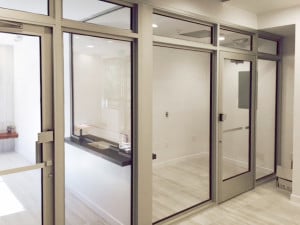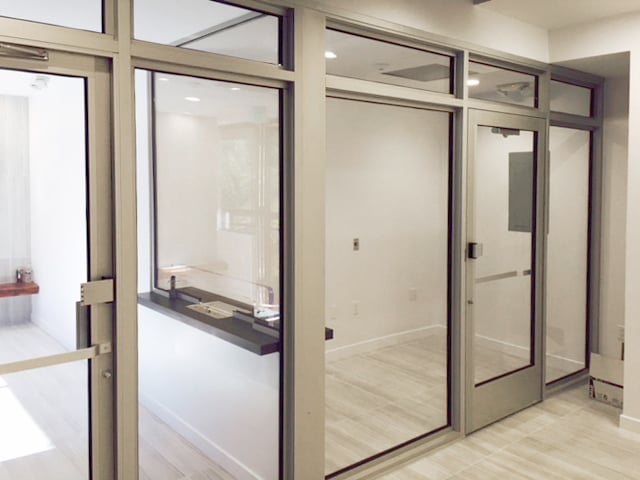In order to improve workplace safety, more companies are choosing to install a higher level of ballistic barriers. This is a major shift. In years past, it would have been uncommon for a corporate workplace to invest in a bullet-resistant barrier rated higher than UL Level 3 (that’s a system designed to stop a close burst from a larger handgun, like a Smith & Wesson .44 Magnum revolver). In many cases, workplaces found that UL Level 1 security was perfectly sufficient (UL Level 1 systems are built to withstand smaller pistols, like the popular 9mm Glock 19). Some companies even installed non-rated doors and glass partitions. That has changed.

Even as violent crime has receded overall, workplace violence is on the rise. In response, corporate clients are securing their businesses with bulletproofing that was once only common in government installations.
“They want to do the right thing,” explains Total Security Solutions (TSS) CEO Jim Richards. “UL level 4 and 5 barriers are becoming common.” These are systems designed to stop high-powered rifles, assault weapons—even resist explosive blasts. “There’s an appreciation that corporate security is really a whole different level than some more traditional clients”(such as banks and retail operations).
Workplace Safety Demands Custom Bulletproof Barriers
Jim has decades of experience designing, fabricating, and installing bullet resistant barrier systems. In that time, the threat landscape had changed tremendously.
As an example, Jim points to the longest-standing bullet resistant barrier customers: banks.
When someone enters a bank with a gun, firing that gun is really the last thing they want to do. Bank robbers want the situation to stay calm and quiet until they are long gone with as much money as possible.
Over time, bullet proof companies have developed fairly standard ways of addressing security in banks and retail. Likewise, in the interest of security, retail clients have changed their building designs and operating procedures.
But when someone steps into an office building holding a gun, “they are there to shoot up the place. Workplace violence has become extremely personal, extremely focused. What are you trying to stop? What are they coming in here to do?”
Corporate offices, manufacturing facilities, data centers, and other workplaces are an entirely different situation. Each is unique, and many are designed to make it as easy as possible to get people and products in and out of the building. This makes it extremely challenging to secure these facilities without disrupting operations.
Choosing The Right Bulletproof Company
Not every bulletproofing company is up to these design and fabrication challenges. For example, TSS has been advising a large global corporate entity with many campuses nationwide. This company has decided that they need to improve security at many of these satellite offices. No two of these spaces are alike. Each location has 200 or more employees on site. They need improved access control and UL Level 3 bullet resistant components (based on known threat profiles). Additionally, they have very specific custom glazing needs. Bullet resistant windows for their facilities will need to meet certain material characteristics (in terms of weight, thickness, durability, and maintainability)—in addition to meeting or exceeding a defined UL-rated performance level.
As Bob George, Senior Sales Consultant at TSS, explains, “They had some problems with some of the initial companies they chose for this project. Not just in being overcharged, but with the quality of the work and components. For example, the company was working with a specific smaller vendor, a door specialist, to add bulletproof doors to their executive suites. Not only did it turn out the vendor was charging a fortune for these doors, but after a few months the frames were starting to split.”
TSS immediately understood what had gone wrong. While this smaller vendor may have known doors, they did not understand that bullet-resistant materials are extremely heavy. Bullet-resistant doors and windows are usually at least twice as heavy as conventional building materials.
“They’d kept the existing wooden frames, and just hung the bulletproof doors in them, with no additional blocking or reinforcement. There was no way those wooden frames could bear that weight.”
Shifting Workplace Safety and Security Needs
“We do a lot of frames, glazing, and doors,” explains TSS CEO Jim Richards. “That’s just like any other building—provided you understand the materials.” Durably increasing security can be as straightforward as adding blocking to doors and swapping out frames prior to installing the UL-rated components. “It stays out of the way. It is bullet-resistant, but it doesn’t look bullet-resistant.”
But an invisible solution isn’t always what a workplace needs. TSS recently completed a project securing the regional distribution center for a major national retailer. This facility had suffered a horrible—seemingly arbitrary—employee-on-employee attack that left four workers dead. That event spurred a great deal of soul-searching within management and a complete transformation of building security. These changes included almost every element of the workplace: staffing, procedures, practices, and the structure itself.
As Bob George noted, “they looked at what we did as the final layer of security for their facility, and their first line of defense.” The centerpiece was a 5-sided guard booth, constructed with continuous mirrored glazing joined at 150º mitered angles. This offered security a continuous 270º view, with no blind spots or distortion. This booth was built to withstand everything from pistol fire to rounds from high-powered and tactical rifles.
No off-the-shelf solution like this existed—and an invisible solution wouldn’t have met two core goals: Increasing actual workplace safety, and increasing workers’ sense that they are safe and secure on the job.
“I like when there’s a system in place afterward,” Jim says. “When you build a system, and people walk in there and can see something’s been done. That appeals to me. The look, the feel, knowing that you’re protecting somebody, and knowing they feel protected.”


